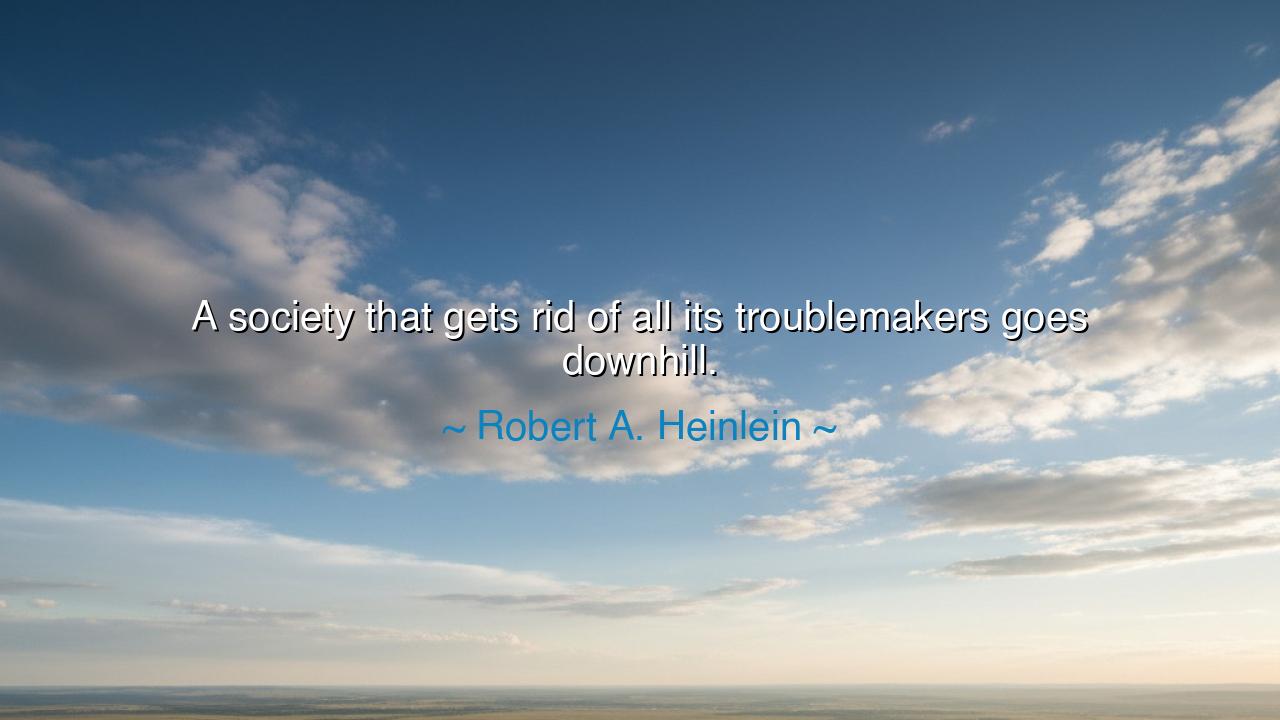
A society that gets rid of all its troublemakers goes downhill.






In the vast chronicles of human history, there has always been a tension between the conformist and the rebel. The troublemakers, those who question, challenge, and disrupt the established order, have often been seen as undesirable by society. Yet, in the words of the wise Robert A. Heinlein, “A society that gets rid of all its troublemakers goes downhill.” This powerful statement speaks not to the chaos that troublemakers sometimes bring, but to the vital role they play in the health and progress of a society. Heinlein suggests that those who challenge the status quo are often the very catalysts for change, growth, and improvement, even when their actions are uncomfortable or inconvenient.
The troublemakers Heinlein refers to are not those who seek only to destroy, but those who stir the pot of complacency, who push boundaries, and who dare to question accepted truths. History is filled with such figures—Socrates, Galileo, Martin Luther, Harriet Tubman, and many others—who, in their time, were seen as troublemakers. They defied the norms of their societies, challenged the authority of those in power, and disrupted the way things were. And yet, through their rebellion, they shaped the course of history, forging paths of freedom, knowledge, and justice that still benefit us today.
Consider the story of Galileo Galilei, a man who stood against the church and the scientific orthodoxy of his time. Galileo’s work on the heliocentric theory—that the Earth revolved around the Sun—was seen as a direct threat to the power of the church. In those days, to challenge the established beliefs of the church was not only a dangerous act but a subversive one. Galileo was tried by the Inquisition, condemned, and forced to recant his beliefs. And yet, in the long run, his troublemaking changed the way we understand the universe. Without his courage to challenge the dogma, the scientific revolution would have been delayed, and our modern understanding of the world would have been far poorer.
The story of Martin Luther provides another powerful example. In 1517, Luther famously nailed his Ninety-Five Theses to the door of the church in Wittenberg, challenging the practices of the Catholic Church, particularly the sale of indulgences. Luther’s act was seen as a rebellion, a disruption of the church’s authority. But in the wake of his actions, the Protestant Reformation was born, fracturing the unity of the church and ushering in a new era of religious freedom, individual conscience, and questioning of authority. Luther’s willingness to be a troublemaker catalyzed a religious and cultural revolution that would shape the world for centuries.
Yet, Heinlein’s words carry a deeper message. Troublemakers are not always revolutionaries with grand ideas of change. Sometimes, they are simply those who refuse to accept the status quo, those who see injustice, inequality, or suffering and refuse to be silent. Harriet Tubman, for example, was a troublemaker in the sense that she refused to accept the institution of slavery in the United States. Her actions, as she guided countless slaves to freedom via the Underground Railroad, were seen as an outright rebellion against the society that allowed slavery to thrive. Yet, in doing so, she helped bring about the end of one of the greatest injustices of human history.
Heinlein’s warning is clear: a society that seeks only peace and order, a society that silences its troublemakers, stifles the very forces that keep it alive and progressive. Without the troublemakers, society would slip into complacency, becoming stagnant, and losing its vitality. It is in the tension between order and disruption, between tradition and change, that societies find their true strength. It is the troublemakers who, through their challenges, force societies to rethink, reimagine,






AAdministratorAdministrator
Welcome, honored guests. Please leave a comment, we will respond soon